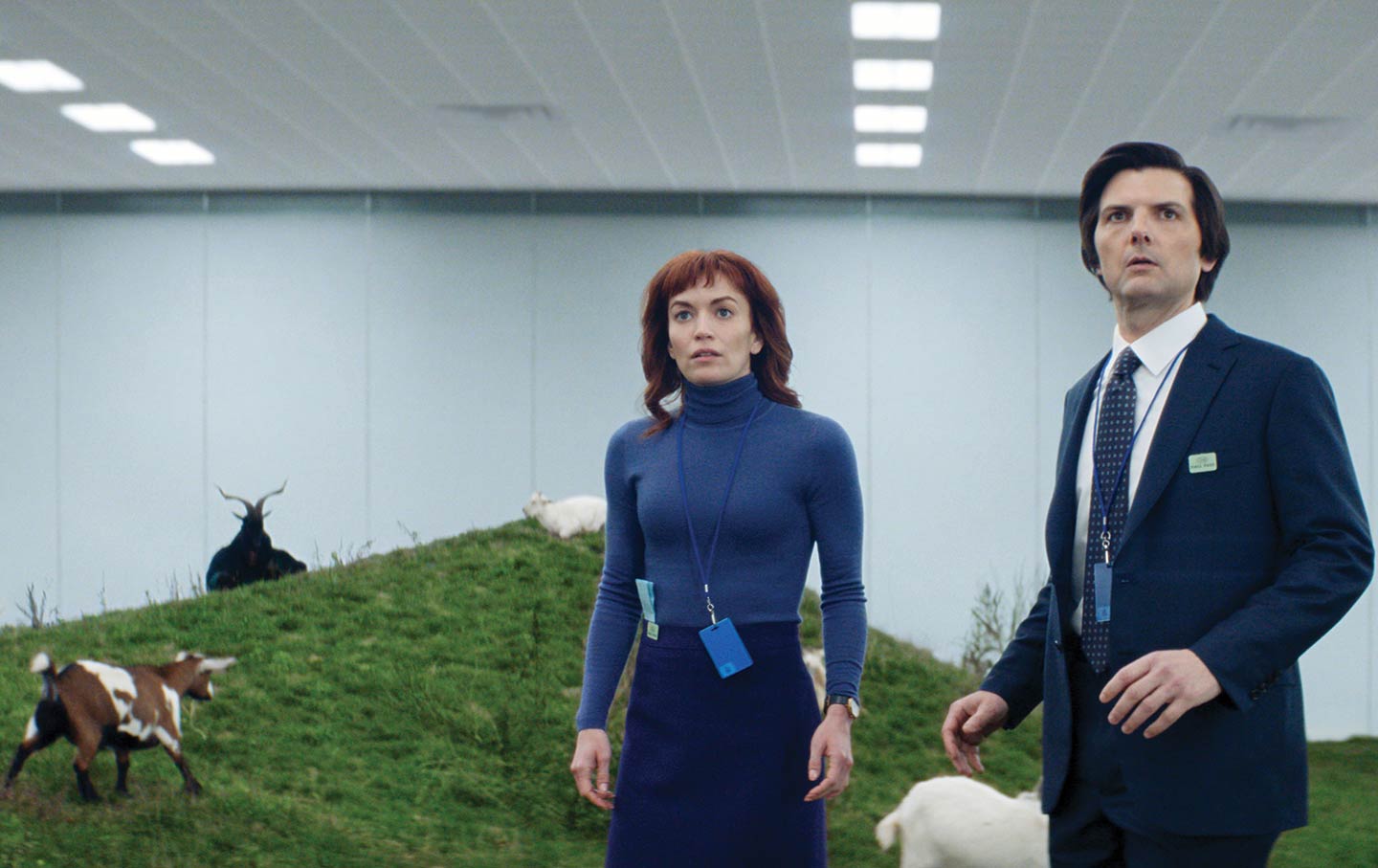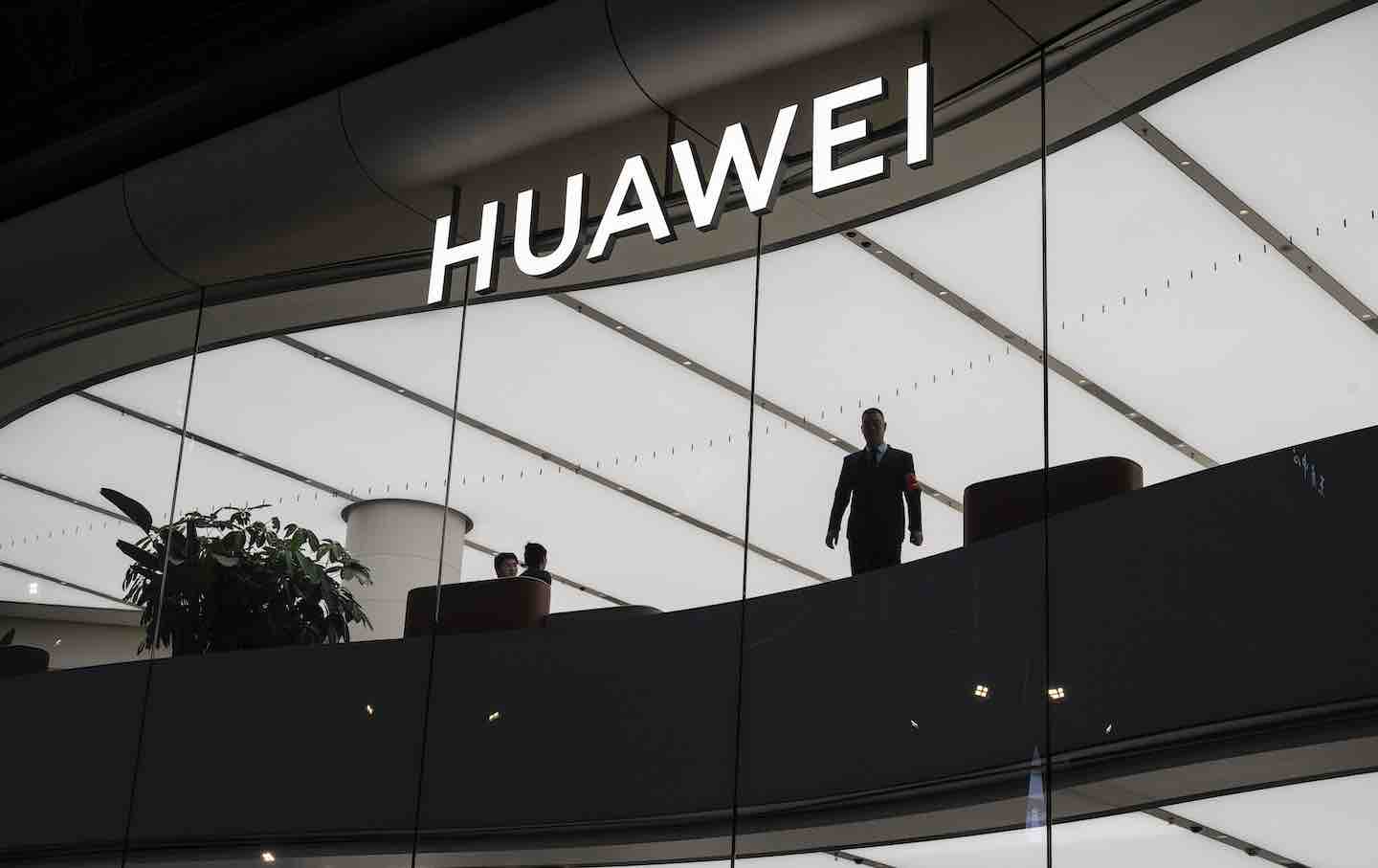Office Politics
The workplace nighmares of Severance.
The Workplace Nightmares of “Severance”
The appeal of the Apple TV+ series is how it dramatizes our alienation from labor.

Do innies have rights? By “innies,” of course, I mean the severed employees of Lumon Industries, relegated to the severed floor of the company’s offices, who work on a project whose true nature is hidden even from them. The medical procedure of severance permanently splits a person into two beings: one who exists outside of Lumon and another whose consciousness exists entirely on that office floor from 9 to 5. Essentially, the “outies” rent out their bodies, but the process of severance creates a whole other person with their own memories and feelings and opinions, whose entire existence belongs to Lumon.
This is the premise of Severance, an Apple TV+ show whose acclaimed first season premiered three years ago, and which has now returned to continue the story of Mark S., the innie fomenting rebellion within Lumon’s walls, and his outie, Mark Scout, who exists outside the company and is consumed by the death of his wife (who, it turns out, might not be dead after all). The appeal of severance for Mark is that it offers eight hours of unconsciousness each day, a release from the grip that grief has on him since his wife’s fatal car accident. The appeal of Severance is that, toggling between these two worlds, it dangles the promise of a mystery that will eventually explain everything.
Despite the show’s stark sci-fi aesthetic, however, the notion that some people seek gain by dehumanizing others from whose labor they benefit is not exactly science fiction. When the show prompts us to ask why Lumon is doing this, it asks us to speculate on the company’s specific aims and not on the conditions of the world that led to this. It’s a show that is often more interested in the what than the why. But if the first season was about workers getting radicalized, the second is much more personal. By dramatizing our alienation from labor, and therefore from life itself, Severance creates the conditions that pit Mark against Mark.
From its premiere, Severance has been one of the most boldly stylized shows on television. We first meet the innies in the only world they know—an office that looks like the hotel lobby from 2001: A Space Odyssey crossed with the dentist’s office from your worst nightmares. Ben Stiller, who established the show’s visual language and directed many of its episodes, formalized the innies’ oppressive conditions in images that feel as overdetermined and airless as their lives. The influence of Stanley Kubrick is clear too in how the visual framing conveys a hypnotic horror: One-point perspective and meticulous symmetrical framing create a deeply ordered world. The negative space and blank uniformity are as withholding as the company that runs the building.
The innies are born as blank slates, so the meaning they derive from their existence is based solely on what they are offered by the company. What do the innies actually do all day? They stare at computer screens showing a matrix of numbers and pore over the digits, looking for a combination that evokes a certain feeling, and then sort them into the bins that correspond to those feelings. Despite the office’s retro aesthetics, they are contemporary workers and their attention belongs to Lumon, like everything else.
Just as the showrunners curate every aspect of the series in order to control information, Lumon carefully fills the innies’ need for meaning. The company provides a god (Lumon’s founder, Kier Eagan) and a sacred text (Kier’s aphorisms). It even has a division that produces paintings depicting its version of the stations of the cross (the Kier Cycle)—Lumon ultimately resembles a religious cult more than a corporation. This tendency mirrors how viewers have engaged the show, treating every absurd background detail as a clue that could lead to some meaningful revelation. But the series is interested in explaining all the wrong things.
Severance is eerie, serious, and deadpan. Like Twin Peaks, it embraces both the humor and the horror in its absurdity. Yet unlike David Lynch’s classic, in which the unexplainable is at the core of what is truly unsettling, Severance holds to its promise that everything you see will fit as part of the puzzle. Something introduced in one season, such as a department that raises baby goats, will be explored in the next. Although the show embraces the appearance of strangeness, its overriding impulse is to be as ordered as Lumon’s offices.
The first season began with the introduction of a new innie, Helly R. (Britt Lower), and her resistance to the lot she’d been given. Her refusal to accept innie life was the engine that started Mark S. (Adam Scott), Dylan G. (Zach Cherry), and Irving B. (John Turturro) down the path to questioning everything they’d been told. This eventually led to all four innies encountering the outie world. The finale was explosive, and it shifted things both inside and outside Lumon.
Season two begins with everyone recoiling from that fissure. The innies try to regroup, their bosses try to do damage control, and the outies are forced to face what they do and do not know about what’s going on at Lumon. Dylan G. makes a connection to his outie’s life that changes his priorities. Helly R., having discovered that her outie has close ties to Lumon, keeps her identity a secret. But in a way that is very television, season two first has to gather back and redirect the energy expelled in that earlier finale before finally following up on the questions raised by season one: What are the innies working on, and where is Mark’s wife?
A lot of that energy goes toward expanding the series’ world. Mark S.’s coworkers have their own relationships to their outies, and comparatively more of the story takes place outside the office, though most of the world-building is still limited to the minutiae of Lumon. We follow the former supervisor of the severed floor as she sets off on her own journey; her deputy, Seth Milchick (Tramell Tillman), is now in charge. Milchick’s bosses are constantly pressuring him about the work his floor is doing—Mark S.’s sorting seems to be the company’s top priority (although, of course, no one ever mentions what the numbers actually mean). Meanwhile, both Marks are distracted: Outie Mark, hoping to find his wife, is trying to infiltrate the offices he goes to every day, while innie Mark, realizing what it means for the innies’ dignity and self-determination, is desperately trying to solve the disappearance of outie Mark’s wife, who is somewhere inside Lumon.
In expanding the locations and characters for their second season, the showrunners loosen the reins on Severance’s claustrophobic insularity, but its visual language becomes less distinctive. When you’re out in the world dealing with real-life locations, it’s a lot harder to have perfectly rigid and manicured frames. As the show’s core fractures, and as the characters spin off into their own storylines, Severance feels more open and less controlled. But this also means that more time is spent with large swaths of the show only tangentially related to one another, and it can all feel like delays and detours from where we know this must end up.
What is the point of all this sinister activity for Lumon? What is the company making, and how is it profiting from what it makes? Severance is about a plan for the total control of labor—a complete alienation of workers from their lives in order to strip them of human feeling. Rather than losing their jobs to automation, the workers of Lumon are themselves made into automatons. And so, whatever else it is, Severance is the story of a worker revolt.
Because the show, like its world, is so withholding and meticulous, everything it brings into the frame is deliberate. Despite the centrality of labor to Severance, it’s a vision of labor that is deracinated and degendered. But in the second season, with the promotion of Milchick, who is Black, the show brings race explicitly into the picture. The superficially gregarious supervisor has a tough time, facing racist slights and micromanaging from his superiors. But Severance struggles to integrate any meaningful insights into the show itself. Despite his verbosity and seeming learnedness, Milchick outwits no one. And in the show’s high-stakes moments, he is little more than a brute easily caged.
But there’s one point in the third episode where Milchick and Natalie—another Black employee of Lumon—share an inarticulate camaraderie. Even though they’re not severed, the fake emotions plastered on their faces show how the emotional labor they perform requires a kind of self-imposed severance. This is not quite the racial ventriloquism of Get Out, but it is about two people trapped inside their laboring bodies. And though they don’t act on it, Milchick and Natalie still feel, just as Mark does, a sense of being trapped. That feeling, the seed of resistance, is what Lumon wants to eradicate.
This is what’s at risk for the company’s severed employees, and possibly for Mark’s wife, Gemma (Dichen Lachman). Finding her means finding out what Lumon is really up to, and maybe what Severance has to say about work. Gemma is the closest to becoming a body without a self, an unfeeling, pliant worker. Does the show know that she’s Asian? Gemma embodies the company’s ultimate intentions, and the efforts to save her connect the innie and outie worlds—but she also connects the series’ world to ours, throwing into stark relief the impossibility of a deracinated, degendered idea of labor. She’s the locus of everything, but the show stops there.
Popular
“swipe left below to view more authors”Swipe →After expanding and sprawling, Severance narrows its focus to this damsel in distress and her rescue. In the end, the series abandons its precise and manicured style for the handheld viscerality of an action sequence. There’s blood and fighting and a love triangle. It’s probably smart storytelling to get so personal, to marry the mystery with everything that matters to the main character. Still, I can’t help but feel a little dissatisfied: If the series’ cold, antiseptic style can be so easily superseded by the personal, then it was nothing more than a visual tactic, not an indictment of a system. And, after all, don’t wait for them to kidnap your wife to revolt.
Hold the powerful to account by supporting The Nation
The chaos and cruelty of the Trump administration reaches new lows each week.
Trump’s catastrophic “Liberation Day” has wreaked havoc on the world economy and set up yet another constitutional crisis at home. Plainclothes officers continue to abduct university students off the streets. So-called “enemy aliens” are flown abroad to a mega prison against the orders of the courts. And Signalgate promises to be the first of many incompetence scandals that expose the brutal violence at the core of the American empire.
At a time when elite universities, powerful law firms, and influential media outlets are capitulating to Trump’s intimidation, The Nation is more determined than ever before to hold the powerful to account.
In just the last month, we’ve published reporting on how Trump outsources his mass deportation agenda to other countries, exposed the administration’s appeal to obscure laws to carry out its repressive agenda, and amplified the voices of brave student activists targeted by universities.
We also continue to tell the stories of those who fight back against Trump and Musk, whether on the streets in growing protest movements, in town halls across the country, or in critical state elections—like Wisconsin’s recent state Supreme Court race—that provide a model for resisting Trumpism and prove that Musk can’t buy our democracy.
This is the journalism that matters in 2025. But we can’t do this without you. As a reader-supported publication, we rely on the support of generous donors. Please, help make our essential independent journalism possible with a donation today.
In solidarity,
The Editors
The Nation








